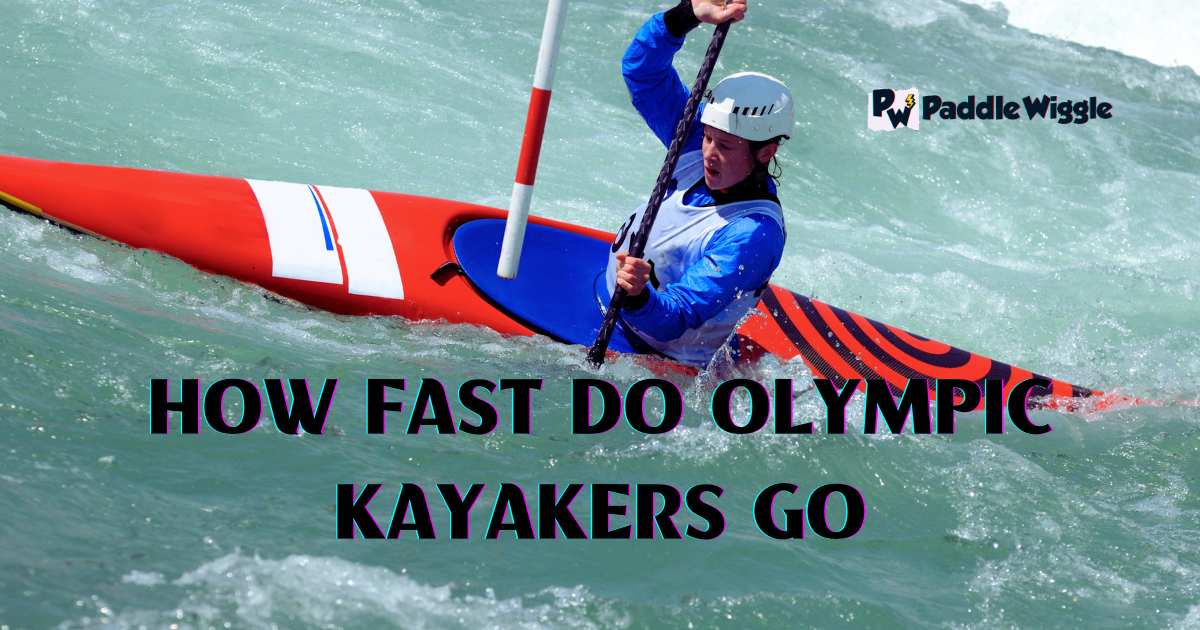When it comes to Olympic kayaking, speed is a crucial factor that distinguishes the best athletes from the rest. Olympic kayakers are known for their impressive speeds. But the question is how fast do they go?
On average, Olympic sprint kayakers can reach speeds of 10 to 12 miles per hour (16 to 20 kilometers per hour) during races.
Athletes navigate through water with precision, using their strength and technique to achieve maximum speed. Olympic kayaking events include both sprint and slalom races, each demanding different skills.
Sprint races require sheer speed over a straight course. Slalom races test agility and control through a series of gates. These athletes undergo rigorous training to hone their abilities. The sport not only tests physical endurance but also mental focus and strategy. This article covers them all.


Contents
Average Speed Of Olympic Kayakers
Olympic kayakers are some of the fastest athletes on water. Their speed is a testament to their skill, training, and the advanced technology of their kayaks. They can reach speeds of up to 12.5 miles per hour. This speed varies based on conditions and athlete skill.
Speeds In Olympic Sprint Events
Sprint events in the Olympics usually cover distances of 200 meters, 500 meters, and 1000 meters. In a 200-meter sprint, Olympic kayakers can achieve speeds of up to 20 kilometers per hour (12.4 mph). For the 500-meter and 1000-meter events, speeds may vary slightly due to endurance factors.
Speeds In Longer-distance Events
For longer distances, such as the 5000 meters or marathon events, the speeds are slightly lower. In these races, Olympic kayakers maintain an average speed of around 12 to 15 kilometers per hour (7.5 to 9.3 mph). Endurance plays a crucial role in these events.
Factors Affecting Speed
- Physical fitness: The athlete’s strength and stamina greatly impact speed.
- Kayak design: Modern kayaks are built to be lightweight and hydrodynamic.
- Water conditions: Calm waters allow for higher speeds, while rough waters slow down the kayak.
Comparing Speeds Across Events
| Event | Average Speed (km/h) | Average Speed (mph) |
| 200 meters | 20 km/h | 12.4 mph |
| 500 meters | 18 km/h | 11.2 mph |
| 1000 meters | 16 km/h | 9.9 mph |
| 5000 meters | 12 km/h | 7.5 mph |
Top Speed Of Olympic Kayaking Events?


Olympic kayaking is an exciting sport that showcases incredible speed and skill. One common question is, “How fast do Olympic kayakers go?” Let’s dive into the top speeds of Olympic kayaking events.
Olympic kayaking events feature a variety of race types, including the K1 200m, K2 500m, and K4 1000m. Each event has its own unique challenges and speeds.
Fastest Speeds In K1 200m
The K1 200m event is a sprint race where solo kayakers push their limits. Athletes can reach speeds of up to 20 km/h (12.4 mph). The short distance demands explosive power and precision.
Speed Dynamics In K2 500m
The K2 500m event involves two kayakers in a tandem kayak. Together, they can achieve speeds of 18 km/h (11.2 mph). Coordination and teamwork are crucial for maintaining high speed.
Top Speed In K4 1000m
The K4 1000m race features four kayakers working in unison. This longer race sees speeds of up to 16 km/h (9.9 mph). Synchronization and endurance are key to success in this event.
| Event | Top Speed (km/h) | Top Speed (mph) |
| K1 200m | 20 | 12.4 |
| K2 500m | 18 | 11.2 |
| K4 1000m | 16 | 9.9 |
Understanding the top speeds of these events highlights the incredible athleticism of Olympic kayakers. Whether solo or in teams, these athletes push their limits to achieve remarkable speeds.
Factors Affecting The Speed Of A Racing Kayak


Olympic kayakers are among the fastest paddlers in the world. They reach astonishing speeds due to their training and the sophisticated design of their kayaks. But what exactly affects the speed of a racing kayak? Understanding these factors helps us appreciate the remarkable performance and velocity these athletes achieve.
Hull Design
The design of the kayak’s hull plays a significant role in its speed. A streamlined, narrow hull reduces water resistance. This allows kayakers to glide faster. The length and shape of the hull also impact stability and pace. Longer kayaks generally move faster in a straight line.
Material And Weight
Lightweight materials like carbon fiber are used to build racing kayaks. This reduces the overall weight, making it easier to paddle at high speeds. Lighter kayaks are more responsive to the kayaker’s strokes, enhancing performance.
Paddle Efficiency
The design and technique of the paddle affect the kayak’s velocity. High-performance paddles are often made from lightweight materials. They have a specific blade shape that maximizes water catch. Efficient paddling technique reduces drag and increases speed.
Water Conditions
Calm water provides the best conditions for racing. Rough water, waves, and currents can slow down kayakers. Olympic courses are designed to minimize these variables, offering a smooth and fast racing environment.
Physical Fitness
Kayakers’ strength and endurance are crucial for maintaining high speeds. Athletes undergo rigorous training to build muscle and cardiovascular fitness. This enables them to paddle powerfully and sustain their pace throughout the race.
Wind And Weather
Wind direction and weather conditions also impact speed. A tailwind can boost a kayaker’s velocity, while a headwind can slow them down. Olympic events consider these factors to ensure fair competition.
Kayaker’s Skill Level
Experienced kayakers have better control and technique. Skilled paddlers maximize their kayak’s potential speed. They efficiently navigate through the course, maintaining optimal performance and velocity.
| Factor | Impact on Speed |
| Hull Design | Reduces water resistance |
| Material and Weight | Enhances responsiveness |
| Paddle Efficiency | Maximizes water catch |
| Water Conditions | Minimizes drag |
| Physical Fitness | Maintains high speeds |
| Wind and Weather | Boosts or slows velocity |
| Kayaker’s Skill Level | Optimizes performance |
Final Words
In short, the impressive speeds of Olympic kayakers show how skilled and dedicated they are. Reaching speeds of 10 to 12 miles per hour (16 to 20 kilometers per hour) highlights their hard work, smart techniques, and advanced equipment. These speeds aren’t just about strength—they also show how well the athletes understand and control their kayaks. As they keep pushing the limits, they not only make the sport better but also inspire new kayakers to aim for greatness on the water.



